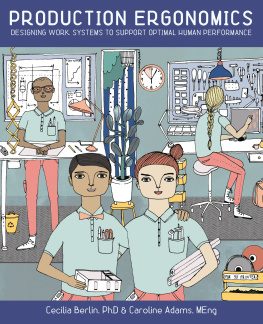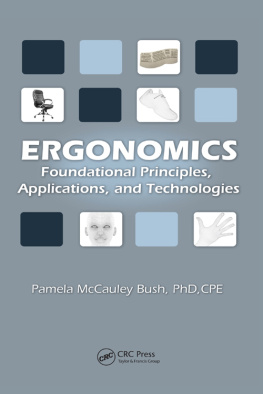Bridger - Introduction to Human Factors and Ergonomics
Here you can read online Bridger - Introduction to Human Factors and Ergonomics full text of the book (entire story) in english for free. Download pdf and epub, get meaning, cover and reviews about this ebook. year: 2017, publisher: CRC Press, genre: Computer. Description of the work, (preface) as well as reviews are available. Best literature library LitArk.com created for fans of good reading and offers a wide selection of genres:
Romance novel
Science fiction
Adventure
Detective
Science
History
Home and family
Prose
Art
Politics
Computer
Non-fiction
Religion
Business
Children
Humor
Choose a favorite category and find really read worthwhile books. Enjoy immersion in the world of imagination, feel the emotions of the characters or learn something new for yourself, make an fascinating discovery.

Introduction to Human Factors and Ergonomics: summary, description and annotation
We offer to read an annotation, description, summary or preface (depends on what the author of the book "Introduction to Human Factors and Ergonomics" wrote himself). If you haven't found the necessary information about the book — write in the comments, we will try to find it.
Bridger: author's other books
Who wrote Introduction to Human Factors and Ergonomics? Find out the surname, the name of the author of the book and a list of all author's works by series.
Introduction to Human Factors and Ergonomics — read online for free the complete book (whole text) full work
Below is the text of the book, divided by pages. System saving the place of the last page read, allows you to conveniently read the book "Introduction to Human Factors and Ergonomics" online for free, without having to search again every time where you left off. Put a bookmark, and you can go to the page where you finished reading at any time.
Font size:
Interval:
Bookmark:

Introduction to Human Factors and Ergonomics
Fourth Edition
Introduction to Human Factors and Ergonomics
Fourth Edition
R. S. Bridger

CRC Press
Taylor & Francis Group
6000 Broken Sound Parkway NW, Suite 300
Boca Raton, FL 33487-2742
2018 by Taylor & Francis Group, LLC
CRC Press is an imprint of Taylor & Francis Group, an Informa business
No claim to original U.S. Government works
Printed on acid-free paper
International Standard Book Number-13: 978-1-4987-9594-4 (Hardback)
This book contains information obtained from authentic and highly regarded sources. Reasonable efforts have been made to publish reliable data and information, but the author and publisher cannot assume responsibility for the validity of all materials or the consequences of their use. The authors and publishers have attempted to trace the copyright holders of all material reproduced in this publication and apologize to copyright holders if permission to publish in this form has not been obtained. If any copyright material has not been acknowledged please write and let us know so we may rectify in any future reprint.
Except as permitted under U.S. Copyright Law, no part of this book may be reprinted, reproduced, transmitted, or utilized in any form by any electronic, mechanical, or other means, now known or hereafter invented, including photocopying, microfilming, and recording, or in any information storage or retrieval system, without written permission from the publishers.
For permission to photocopy or use material electronically from this work, please access www.copyright.com (http://www.copyright.com/) or contact the Copyright Clearance Center, Inc. (CCC), 222 Rosewood Drive, Danvers, MA 01923, 978-750-8400. CCC is a not-for-profit organization that provides licenses and registration for a variety of users. For organizations that have been granted a photocopy license by the CCC, a separate system of payment has been arranged.
Trademark Notice: Product or corporate names may be trademarks or registered trademarks, and are used only for identification and explanation without intent to infringe.
Library of Congress Cataloging-in-Publication Data
Names: Bridger, R. S., author.
Title: Introduction to human factors and ergonomics / Robert Bridger.
Other titles: Introduction to ergonomics
Description: Fourth edition. | Boca Raton : Taylor & Francis, CRC Press, 2018. | Earlier editions published under title: Introduction to ergonomics. | Includes bibliographical references.
Identifiers: LCCN 2017023573| ISBN 9781498795944 (hardback) | ISBN 9781498796118 (ebook)
Subjects: LCSH: Human engineering. | Work environment.
Classification: LCC TA166 .B72 2018 | DDC 620.8/2--dc23
LC record available at https://lccn.loc.gov/2017023573
Visit the Taylor & Francis Web site at
http://www.taylorandfrancis.com
and the CRC Press Web site at
http://www.crcpress.com
Contents
My main objective in writing this new edition has been to put Human Factors and Ergonomics (HFE) into a bigger box : to provide first-time students with a greater awareness of the systems context in which HFE is used; systems lifecycle concepts such as the CADMID cycle and to make this book more usable than it was by project teams. To this end, I have added a new Prologue dealing with system concepts and included more material on general aspects of systems design and evaluation throughout this book. Some key concepts in systems thinking are introduced early on and are illustrated using HFE examples including gathering and writing requirements; functional design and allocation of function; and the use of HFE in quality assurance. These ideas have been carried forward into all of the subsequent chapters, such that the reader can learn how to write specific requirements in particular domains and carry out acceptance testing to check whether the requirements have been met.
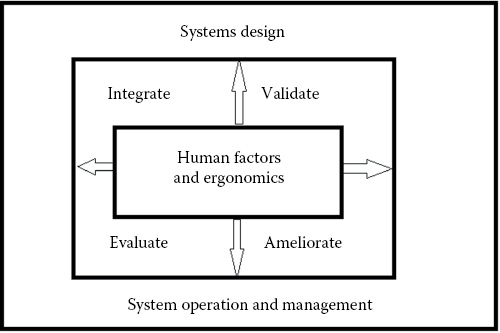
HFE Works Best in a Bigger Box
A human-centered approach has been taken to organize the sequence of chapters in this book, as is illustrated in the model below. This way of presenting the information reflects the maturity of the underlying disciplines as reflected in international standards, where our knowledge within a particular domain is much more developed than our knowledge of the interactions between different domains. The model also serves to organize the chapters in relation to core scientific concepts and their basic applications.
A HumanMachine Model (adapted from prEN 14386: 2002(E)
In accordance with the model, there are chapters on body mechanics and dimensions, the senses, human information processing, and so on. The interactions between these elements of the human subsystem and the corresponding controls, displays, and other elements of the technical subsystem are described. Requirements for optimal design of systems are derived from an understanding of the human/technical subsystem interactions between the different elements.
Each chapter begins with a list of general human requirements that must be met when a system is designed. These requirements will help HFE specialists put HFE on the table early in the design cycle.
Within each chapter, the knowledge is organized using the standard model below in order to make it easier for readers to navigate HFE across the core disciplines.
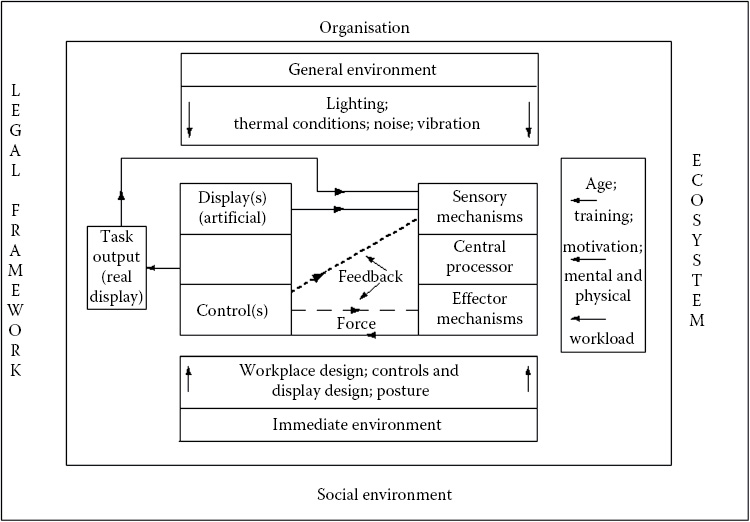
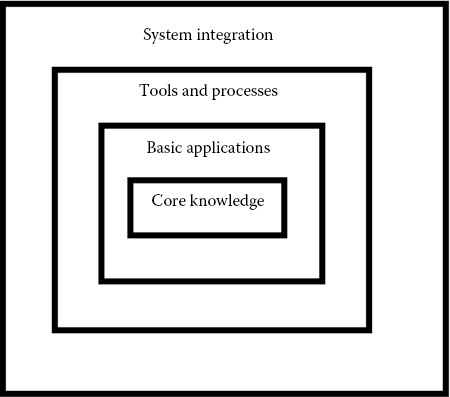
Standard Model for the Organization of HFE Material in Every Chapter
Each chapter begins with a review of the core knowledge concerning the particular human elements, the scientific terminology, definitions, units and descriptions, and discussions of human physical and psychological subsystems. Some basic applications of this knowledge are then described followed by the tools and processes and a discussion of some of the wider issues of systems integration, including cost effectiveness and considerations of how the basic concepts of HFE can interact with each other when systems are put together. From the core knowledge and basic applications, requirements can be derived and developed and examples are given throughout this book. The tools and processes can be used for assurance purposes at any point in the system lifecycle, but preferably before the system is accepted for use. Cost-effectiveness arguments can be used during the design process and afterward to promote proper integration of HFE into the system and counter the arguments that inevitably arise when requirements are traded-off against each other.
In revising a textbook such as this, a compromise has to be made between presenting the latest research, without knowing how long it will be relevant and preserving the best research of the past without turning this book into a museum. Readers of previous editions will find much that is familiar: a focus on core knowledge across HFE; citations of classic research; examples of statistical; and other methods such as risk assessment toolsall of which are essential and widely used today. As core application areas mature and as tools are better validated, the need for lengthy discussions of supportive research diminishes and the need for explanation and validation of methods increases. Similarly, changing content reflects a changing world as the need for material on information technology is superseded by the need for more discussion of the Internet and issues such as sustainability; similarly, the traditional emphasis on physically demanding work gives way to the problems of occupational inactivity and associated problems such as obesity.
Font size:
Interval:
Bookmark:
Similar books «Introduction to Human Factors and Ergonomics»
Look at similar books to Introduction to Human Factors and Ergonomics. We have selected literature similar in name and meaning in the hope of providing readers with more options to find new, interesting, not yet read works.
Discussion, reviews of the book Introduction to Human Factors and Ergonomics and just readers' own opinions. Leave your comments, write what you think about the work, its meaning or the main characters. Specify what exactly you liked and what you didn't like, and why you think so.



